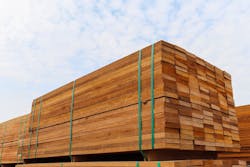Despite a fall in lumber prices, costs are more than double pre-pandemic levels, but there remains a disagreement on why prices are so high and what the solution could be. The United States and Canada have feuded over softwood lumber since the Reagan administration: The U.S. supports higher tariffs on Canadian lumber imports to strengthen domestic production, but Canada deems it unfair. The dispute over lumber has gone on for so long that each dispute has a number, says the New York Times. The current one is deemed Lumber V. Home builders and sawmills are in disagreement now as the National Association of Home Builders have called on the U.S. government to ease lumber tariffs, but domestic lumber producers say those tariffs impact lumber prices minimally.
The friction between the United States and Canada over softwood lumber stems in large part from the differences in how timber is harvested in the two countries. While most timberland in the United States is privately owned, most of Canada’s forestland is publicly owned, and companies pay fees set by provincial governments to harvest timber from their land.
American lumber producers contend that the fees are artificially low and amount to an unfair government subsidy. The United States and Canada have reached a series of agreements over the years regarding lumber imports into the United States, but the most recent deal expired in 2015.
“The core problem, and partly why you can never resolve this, comes down to structure,” said Eric Miller, a former Canadian official and the president of the Rideau Potomac Strategy Group, a consultancy.
In 2016, toward the end of the Obama administration, the American lumber industry petitioned the government to impose duties on Canadian softwood lumber imports in response to what it contended were unfair trade practices. The proceedings continued under the Trump administration, which in 2017 imposed duties of 20.2 percent for most Canadian producers. The rate was lowered to 9 percent last year.
The status of the long-running dispute took on a new urgency as the price of lumber soared over the past year. The National Association of Home Builders estimated in April that higher lumber costs had added nearly $36,000 to the price of an average newly constructed single-family home. A benchmark for the price of framing lumber set a record high of $1,515 per thousand board feet in May, four times the price at the beginning of 2020, before beginning to plummet. Last week, the price stood at $930, still more than double its level at the start of 2020, according to Fastmarkets Random Lengths, the trade publication that publishes the benchmark.
“As an economist, it is very hard to understand why we’re taxing something we don’t produce enough of,” said Robert Dietz, the chief economist for the National Association of Home Builders.
